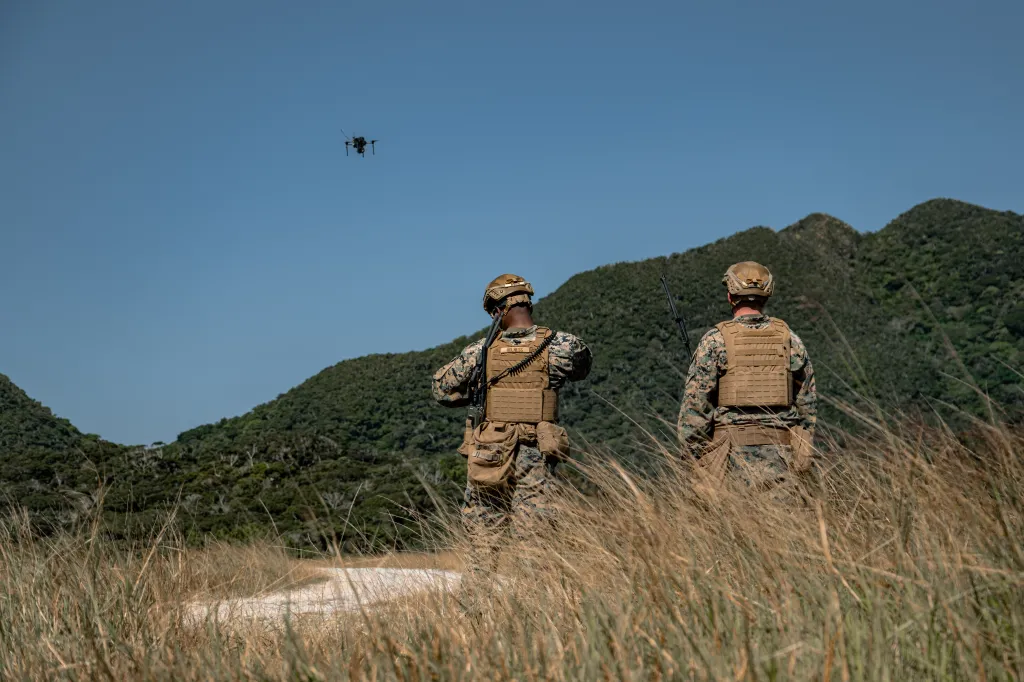Marines Seeking 10,000 First-Person View Drones At $4K A Pop
The U.S. Marine Corps is looking for companies that can provide 10,000 first-person view drones by Jan. 1, 2027, according to a Request for Information (RFI) posted Thursday on a government procurement website. While just a minute fraction of the number of FPV drones being used by both sides of the war in Ukraine monthly, the RFI is the latest move by the Marines to put these swift and maneuverable weapons into the hands of its troops. It was issued as the Pentagon seeks to dramatically increase drone supplies across the services.
The USMC, as we have previously noted, wants strike weapons at the squad level with far greater reach than rifles and mortars. The Corps has created “attack drone teams” to integrate the lessons in Ukraine about the effectiveness of these weapons against personnel and equipment into their formations. We’ll talk more about those teams later in this story.

The use of FPV drones by both Russia and Ukraine has changed the face of war. They have enabled small units to strike targets in some cases as far away as 40 kilometers, though more typically less than half that distance, greatly extending the depth of the front lines.
The Marines want the same capabilities.
“FPV drones offer squad-level lethality up to 20 kilometers for under $5,000, compared to more expensive weapons systems with less capability,” the Marines explained in March. “This provides a cost-effective and scalable solution for modern combat.”
The RFI, published on Thursday, is one step toward meeting that goal. It calls for FPV drones costing less than $4,000 per unit for the aircraft, with the understanding that ground-control stations, communications equipment, goggles, batteries and charging stations for swarming will add to the price tag.
These can be controlled by radio frequencies as well as fiber optic cables. First employed by Russia last year, these cable-controlled drones are now widely used by both sides because they are immune to jamming and many other forms of electronic warfare. They also help mitigate interference from geography and structures that can impede radio signals.

The use of these types of FPV drones has become so ubiquitous that some Ukrainian cities are covered in cables, which you can see in the following video.
The Marines are also seeking designs that can be easily converted from non-kinetic to multiple different kinetic payloads by troops on the front lines. In addition, the RFI calls for drones giving Marines the ability to “modify, within reason, the system with a variety of third-party payloads, armaments, and munitions without vendor involvement.” The Corps also wants the ability to repair these drones by itself, without vendor involvement, a critical need in any swiftly evolving fight.
There are no requirements listed for speed, range, altitude, or payload weights; however, the RFI asks that interested companies provide those specifications. Regardless, the Corps is looking to move out quickly — at least in terms of notoriously sluggish U.S. military procurement norms — on this effort. The RFI calls for the delivery of an initial tranche of these weapons by Jan. 1, 2027, “with the ability to quickly ramp production and deliver larger quantities up to 5,000 air vehicles within 6 months and 10,000 units within 12 months.”
The RFI comes as the Marines are testing FPV drones to see how they function in simulated combat and to certify troops on their use. There have been at least two examples of that since November alone.

Earlier this month, the 3rd Marine Division, III Marine Expeditionary Force, participated in the Marine Corps Attack Drone Competition at Camps Hansen and Schwab, Okinawa, Japan.
“The competition put Neros Archer, first-person view attack drones into the hands of the Division’s capable warfighters,” the Marines said in a release. The Neros Archer is “capable of carrying a 2 kg/4.5 lb payload over 20 kilometers,” the company asserts on its LinkedIn page. In November, the company was awarded a $17 million contract to provide about 8,000 drones, including kinetic-strike capable FPVs, to the Corps. It was previously awarded a contract under the U.S. Army’s Purpose-Built Attritable Systems (PBAS) program and had produced 6,000 of these drones for Ukraine.

The attack drone competition on Okinawa allowed Marines “to test and improve their drone skills alongside the top operators in the Marine Corps, enhancing their confidence and capabilities on the battlefield,” said U.S. Marine Corps Sgt. Grant Doran, an attack drone instructor with the Marine Corps Attack Drone Team in Quantico. “It also lets us train the people who will be taking over our positions in the future. Other branches were also able to bring their top operators in, so we can share our tips and tricks to increase lethality across all services.”
The certification “increased 3rd Marine Division’s tactical drone use in both offensive and defensive scenarios,” the division explained. “The Neros Archer drone extends the Marines’ understanding of the battlespace by 20 kilometers, and this capability increases the Marines’ lethal reach and ability to attack using precision weapons.”
“I believe that with [any potential] crisis, small Unmanned Aerial Systems development and integration within small unit formations is going to be super relevant given its longer reach,” Doran posited.

In November, the Marine Corps Battalion Landing Team 3/6, 22nd Marine Expeditionary Unit (Special Operations Capable) conducted FPV attack drone training on Camp Santiago, Puerto Rico.
“The 2d Marine Division and the Marine Corps Attack Drone Team are training and certifying 22nd MEU(SOC) Marines on the Neros Archer first-person view drone system, demonstrating the 22nd MEU(SOC)’s commitment to innovation, adaptability, and enhanced combat readiness,” a release explains. That training came as the U.S. was ramping up its Operation Southern Spear campaign against drug traffickers and Venezuelan dictator Nicolas Maduro, which you can read more about here.

22nd MEU FPV Drone Training
The RFI and the recent competition and training come after the Corps announced the establishment of its experimental Marine Corps Attack Drone Team (MCADT) at the service’s base in Quantico, Virginia, earlier this year.
MCADT’s creation was a direct response to “the rapid proliferation of armed first-person-view drone technology and tactics observed in modern conflicts, particularly in Eastern Europe,” the Marines said in a press release issued back in March. “As emerging threats continue to evolve, the Marine Corps is prioritizing the integration of FPV drone capabilities to enhance lethality and operational effectiveness across the Fleet Marine Force.”
The Marine Corps’ growing interest in FPV drones is unfolding as their use, popularized by the war in Ukraine, has spread to conflicts across the globe by states and non-state actors. Still, it is important to note, as TWZ regularly does, that the threats posed by weaponized uncrewed aerial systems, including small modified commercial designs, far predate the all-out war in Ukraine. The following image shows a drone used by a Mexican cartel in 2020.

The U.S. is increasingly heeding the wake-up call emanating from the battlefields of Ukraine. In July, War Secretary Pete Hegseth unveiled an ambitious Pentagon-wide effort to dramatically boost the number of troops armed with small drones. Earlier this month, the Pentagon unveiled its $1 billion “Drone Dominance” program to purchase hundreds of thousands of kamikaze drones of all types. Last month, the Army announced its own plans to purchase a million kamikaze drones over the next two to three years and recently signed a $1 billion agreement to purchase Switchblade-series loitering munitions. These Trump administration efforts, among several others, have subsumed the Biden administration’s $1 billion Replicator program, created to buy small drones.
The Marines, meanwhile, have a separate program to spend hundreds of millions of dollars on small drones. In April 2024, the Marine Corps Systems Command (MARCORSYSCOM) awarded three companies – Teledyne FLIR Defense, AeroVironment and Anduril Industries – an Indefinite Delivery/Indefinite Quantity contract worth up to $249 million under its Organic Precision Fires-Light (OPF-L) program. The most recent order came earlier this month, when the Corps agreed to purchase 600 Rogue-1 loitering munitions from Teledyne FLIR Defense for $42.5 million, or about $71,000 a piece. That follows an initial $12 million order for 127 Rogue-1s, which had a price tag of about $90,000 per unit.

As the Marines eye a potential future peer conflict where drones will play a huge role, there is another lesson from the Ukraine war to consider. Magazine depth for these weapons is critical, which is why the Corps is also looking for a mix of short-range, troop-controlled drones, including ones far cheaper, albeit less capable in some ways, than the Rogue-1.
Still, the procurement of 10,000 FPV drones, as we noted earlier in this story, pales in comparison to what is seen in Ukraine, a nation in an existential fight. Kyiv, for instance, plans to produce 4.5 million FPV drones by the end of this year. Russia, for its part, plans to produce 2.5 million of these weapons. Still, Ukraine is a unique, well-established conflict with largely static lines, and is not what the U.S. would likely face in the Pacific, for instance, where FPV drones won’t be needed in such massive quantities. Still, FPV drones will be a staple of land warfare going forward.
Though its goals are comparatively small in number, the RFI is a small step toward closing the Pentagon’s yawning drone development and procurement gap that TWZ has frequently highlighted.
Contact the author: howard@thewarzone.com





